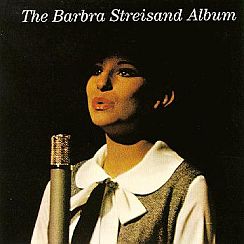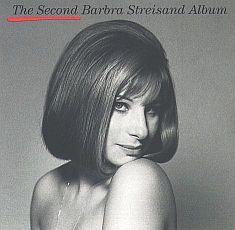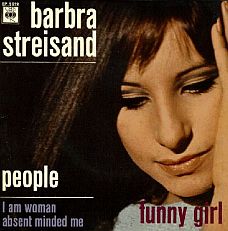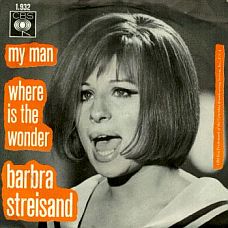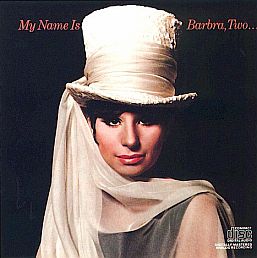
Barbra Streisand during rehearsal for 'Funny Girl' in New York City, January 1964. (AP photo)
Born in 1942 and raised in Brooklyn, New York, Barbra Streisand had a tough start in childhood. Her father, a grammar school teacher, died when she was 15 months old. Her mother — left with young Barbra and an older son Sheldon — took a job as a bookkeeper and moved in with her parents. As a little girl growing up, Barbra sang in the hallways of her apartment building. “Barbra started to sing as early as she could talk,” her mother later recalled. Young Barbra set her sights on becoming an actress, framed in part by what she saw on television. In 1949, her mother remarried, to Louis Kind — a step-father of conflict for Barbra and not a happy time. A sister, Roslyn, was born in 1951.
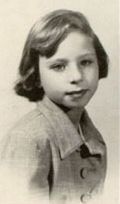
Young Barbra, 1950s.
In 1959, Barbra graduated high school, fourth in her class, but did not attend college. With her sights set on acting, she moved to Manhattan. She was 17 years old.
Vagabond Days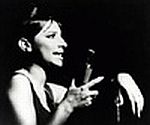
Barbra Streisand at the Bon Soir nightclub, 1960.
During her early days in Manhattan, Streisand occasionally lived with friends, carrying a folding cot around. She was something of a vagabond and dressed in the latest thrift-store chic. She worked odd jobs and tried to enter the famous Actors Studio, but failed. She tried some off-Broadway acting, appearing in one play that ran only a few times. Although her heart was set on acting, in June 1960 she entered and won a singing competition at a local Greenwich Village bar, the Lion, with no singing experience. “They laughed when she stood up to the microphone,” Pete Hamill would later write of the audience’s reaction to her clothes and her first club appearance, “but when she sang there was no contest.” “They laughed when she stood up to the micro-phone, but when she sang there was no contest.”
– Pete Hamill She then put together a night club act with the help of a friend and began performing in other Greenwich Village gay bars, such as The Bon Soir, where she was well received. By 1961, she began venturing beyond Manhattan, appearing in clubs such as the Caucus Club in Detroit, the Crystal Palace in St Louis, and the Town and Country Towers room in Winnipeg, Canada. Those who heard her sing were quite taken by her performances and her voice. But not everyone understood or appreciated her interpretations. A few early reviewers called her quirky, but one noted “a confidence beyond her years”and predicted that despite her unusual singing style and vintage clothes, she could go “right to the top.” Back in Manhattan she was attracting a growing following at clubs such as the Bon Soir and the Blue Angel, and in some corners of the music industry. While club performing, she met Jack Paar, the late-night TV talk show host, who asked her to appear on his show. She made her national TV debut on The Jack Paar Show April 5th, 1961 and made a second appearance on May 22, 1961.
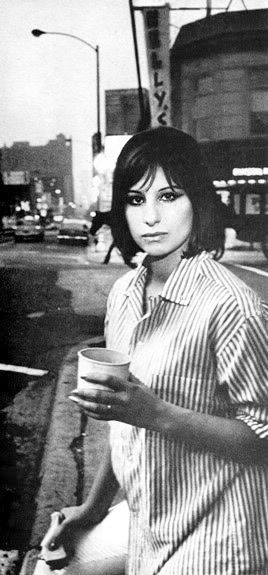
Fall 1962: Barbra Streisand during auditioning days, while trying out for new Broadway shows.
Mike Wallace & Broadway
Streisand also began appearing on a late night New York-based TV talk show called PM East, a show that Group W and Westinghouse created to compete with Jack Parr. One of the hosts of that show was Mike Wallace, later of 60 Minutes fame, but with whom Streisand struck a chord. Her first show there was in July 1961, and she became something of regular, appearing more than a dozen times through 1961 and 1962. On the show, in addition to singing, she also became known as a talkative and sometimes zany guest, engaging Wallace and the others in lively exchanges. By December 1961, she had also prepared an audition tape of her club songs for RCA Records, but no contract was offered.
In 1961, after Broadway auditions that fall, she landed a small acting and singing part as a secretary in, I Can Get It For You Wholesale, a Depression-era story about an unscrupulous businessman in the garment district.
When the show opened on Broadway on March 22, 1962, Streisand had the stage to herself in one scene doing a song and skit bemoaning her secretarial plight. She gave a spirited performance, which by one account brought audience attendee Leonard Bernstein to his feet applauding wildly. Bernstein was sitting in the VIP orchestra section that night, and the audience agreed with his reaction, giving Streisand a sustained ovation for her performance.
“What we had witnessed, and what brought Bernstein’s enthusiasm,” wrote John Bush Jones, also in the audience that night, “was the Broadway debut of an unknown nineteen-year-old performer named Barbra Streisand.” Streisand was later nominated for, but did not win, a Tony Award for Best Featured Actress in a Musical.
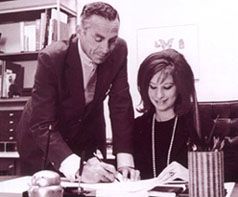
Barbra Streisand signing recording contract with Columbia's Goddard Lieberson, Oct 1962.
By the fall of 1962, three record labels were interested: Atlantic, Capitol, and Columbia. Capitol made an offer, but Streisand agreed to sign with Columbia on October 1st, negotiating creative control over her material and album covers. That fall she was also auditioning for new Broadway shows. But it was her appearance on The Ed Sullivan Show December 16, 1962 singing “My Coloring Book” and “Lover, Come Back To Me” that helped introduce Barbra Streisand to a larger, more mainstream national audience.
On February 25, 1963, her first studio album for Columbia Records was released, The Barbra Streisand Album, which included her interpretations of eleven pop standards. The album was very well received and first appeared on the Billboard albums chart the week of April 13, 1963. It would peak at #8 on that chart and 18 months later achieved “gold” sales status — i.e., 500,000 copies or more. It would also win 1963 Grammy Awards for Album of The Year and Best Female Vocalist.
One of the album’s songs, “Happy Days Are Here Again,” wasn’t much more than a jingle before Streisand’s interpretation — “sung so slowly that suddenly all the hidden irony and banality of it come shaking out like loose nails,” wrote one reporter in Time magazine. The Barbra Streisand Album, meanwhile, remained in the Top 40 for 74 weeks.
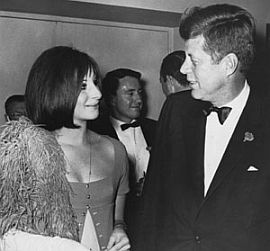
Barbra Streisand meeting JFK at White House Press Correspondents dinner, May 1963.
Among those who saw Streisand’s performance on Dinah Shore was President John F. Kennedy, resulting in an invitation for her to sing at the White House Press Correspondents Dinner on May 24, 1963, when she met Kennedy. Columbia Records, meanwhile, in April, had re-released Streisand’s “Happy Days” song for radio play to gain her more public exposure.
By July 1963, a young Pete Hamill was writing about Streisand’s rising star — “Goodbye Brooklyn, Hello Fame” — in The Saturday Evening Post. That summer, she landed the role to play the famed comedienne Fanny Brice in the Broadway musical Funny Girl, slated to open in early 1964.
The Second Barbra Streisand Album was released in August 1963, surpassing the first, jumping into the Top Ten on the Billboard charts and peaking at No. 2. The record stayed at the No. 2 spot for three weeks and was certified gold after 13 months. By late September 1963, after completing a good month of performances at Hollywood’s Cocoanut Grove, Barbra Streisand was commanding a nightclub salary of $15,000 a week. Throughout 1963, she had played at clubs all across the country. Reported Look magazine that November:“From coast to coast, hypnotized patrons line up outside nightclubs to hear her almost overwhelming presentations of such items as ‘Happy Days Are Here Again’ and ‘Cry Me a River’. She puts every nerve ending, muscle tendon and female oomph unit she has into a song; at the end of an evening, the audience is washed out.”
Two major TV appearances came as well — one on NBC’s Bob Hope Comedy Special, broadcast September 27, 1963 and the other on October 6, 1963 on The Judy Garland Show (CBS). Her performance on Judy Garland’s show would earn Streisand an Emmy nomination for Best Variety Performance, the first time a guest star had ever received such an honor.
In mid-January 1964, Funny Girl had its first public showing in Boston, but it bombed, in part because of a snow storm, but also poor reviews. The play was reworked by Jerome Robbins, who gave Streisand more songs and comedy, placing more of the show’s success or failure on her performance. Meanwhile, her third album — simply titled The Third Album — was released in February 1964. The cover featured a photo of Streisand performing from The Judy Garland Show. This album was also a hit, reaching No.5 on Billboard’s album chart. It also certified gold.
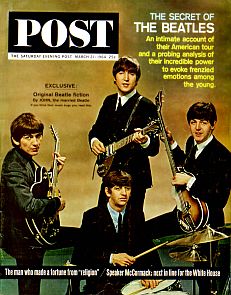
'Saturday Evening Post', 21 March 1964.
Streisand was pumping out her repertoire of old standards at a time when the rock ‘n roll revolution was underway. The market for rock ‘n roll music was exploding, transforming the industry and changing popular culture. In the early 1960s, “girl groups” such as the Shirelles and Crystals were prominent on the singles charts, and by 1963, the Angels, the Chiffons, and Martha and Vandellas were making their mark. Jan & Dean, the Four Seasons, Little Stevie Wonder, and the Supremes had hits too. In 1964, the Beatles took over much of the popular scene, following their February 9th appearance on The Ed Sullivan Show — the first of three. By early April 1964, Beatles singles held the top five spots on Billboard’s Hot 100 — among them, “She Loves You,” “I Want to Hold Your Hand,” and “Please, Please Me.” Other artists, including Bob Dylan, Joan Baez, the Beach Boys, and various Motown groups, were also cranking out new songs and albums. But Streisand’s standards held their own, especially on the Billboard albums chart. And there was more to come.
Funny Girl Fame
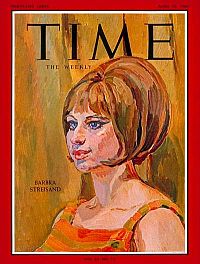
Barbra Streisand, star of 'Funny Girl,' Time cover story, 10 April 1964.
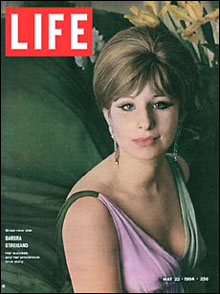
Barbra Streisand, Life magazine cover story, 22 May 1964.
In addition to competing with Beatles’ albums, such as A Hard Day’s Night which had been released in June, there were also a number of other rising contemporary artists at that time with new albums. Among rock `n roll artists with new releases then, for example, were: the Beach Boys with All Summer Long in mid-July; Bob Dylan and The Animals from the U.K. with new albums in August; The Kinks’ and Rolling Stones had new releases in October; and the debut album of Simon & Garfunkel, Wednesday Morning, 3 A.M. came that month as well. Sam Cooke’s Ain’t That Good News appeared in December 1964.
Music Player
“People”-Barbra Streisand
Still, amid all this popular competition, Streisand’s work continued to rise in the popular arena. Her release of the single “People,” for example, climbed into the Top 40 in late May 1964, peaking at No. 5. It was her first Top 40 hit, and it remained on the Top 40 list for 12 weeks, through August. It was also a No. 1 hit on the Pop Standards chart, also known as the Adult Contemporary chart, holding forth there through June and July 1964.
LBJ & CBS Special
In 1965, Streisand began the year by entertaining newly elected President Lyndon Johnson at the Democratic Inaugural Gala on January 18th in Washington, D.C. On April 4th she attended a civil rights fundraiser in Selma, Alabama where she sang “That’s A Fine Kind of Freedom.” A week later, at the Grammys she took home the Best Female Vocalist award for “People.”At a civil rights fundraiser in Selma, Alabama she sang “That’s A Fine Kind of Freedom.” A week after that, on April 14th, she completed the taping for her first TV production, “My Name Is Barbra,” a one-woman musical special entirely her own show without any guest stars. Some people at CBS feared the program would be a disaster. When it aired on April 28th, the critics loved it and it earned high audience ratings (For a time on YouTube, a clip of Streisand singing a fine rendition of “Happy Days” at the end of the show was available, since taken down). The CBS TV special was followed by the companion album, My Name Is Barbra, released in May 1965. A single from the this album, “My Man,” released in June 1965, made the Billboard Hot 100 in July, peaking at No. 79 and remained on the chart for six weeks. Her first TV show meanwhile, was nominated for five Emmy Awards, winning all five at the September ceremony, including two for Streisand herself.
Musically in 1965, the rock ‘n roll juggernaut was as strong as ever. Among artists with No.1 hits that year were: The Beatles, The Supremes, Petula Clark, The Righteous Brothers, The Temptations, The Beach Boys, The Four Tops, The Byrds, Sonny & Cher, The Rolling Stones, and others. Many of these groups had top albums as well.In the midst of this, Streisand’s second album in 1965 – My Name is Barbra, Two – was released in October. It made the Billboard album chart in November, peaking at No.2. It would also sell 500,000 copies and reach gold certification within three months and remain on the charts for 48 weeks.
On December 1st, 1965, Streisand’s career took a new turn, as she signed her first film contract — a four-picture deal beginning with the film adaptation of Funny Girl, which would not reach the big screen until 1968. Meanwhile, her albums were selling like crazy, and would continue to sell through the 1960s, boosted in part by her TV specials. During the decade, nine of her albums would reach the Top 10.
|
Barbra Streisand The Barbra Streisand Album The Second Barbra Streisand Album Barbra Streisand: The Third Album Funny Girl (Broadway cast album) People My Name is Barbra My Name is Barbra, Two |
Just Getting Started
In six short years Barbara Streisand had taken the entertainment world by storm. From her early vagabond days of carrying a folding cot around in 1960, to entertaining at the White House and launching her own TV specials in 1965, Barbara Streisand had rocketed to the top of popular music, Broadway, and prime-time television.
She was now 23 years old, a millionaire, and one of the world’s most popular female recording artists. But there was still much more to come. There were 30 or more albums ahead, a career in film (acting, directing and producing), mega concerts, political activism, and a whole lot more. Barbra Streisand was just getting started.
See also at this website, “Memory & Cats”, which includes Streisand singing the poignant song “Memory” from the hit play, Cats. Additional stories on music can be found at the “Annals of Music” page, and for famous women and their careers see “Noteworthy Ladies,” a topics page with 40 story choices in that category. Thanks for visiting – and if you like what you find here, please make a donation to help support the research and writing at this website. Thank you. – Jack Doyle
|
Please Support Thank You |
______________________
Date Posted: 10 May 2008
Last Update: 15 November 2023
Comments to:
jackdoyle47@gmail.com
Article Citation:
Jack Doyle, “Streisand Rising, 1961-1965,”
PopHistoryDig.com, May 10, 2008.
_____________________________
Sources, Links & Additional Information

1963: Barbra Streisand, with then husband Elliott Gould, Beverly Hills Hotel pool. Photo, Bob Willoughby.
Barbra Streisand’s Official Website.
Barbra Streisand, My Name Is Barbra, November 2023, Viking Press, New York. Click for copy.
“Barbra Streisand, 29th AFI Life Achievement Award,” American Film Institute, 2001, AFI.com
John Bush Jones, Our Musicals, Ourselves: A Social History of The American Musical Theater; Brandeis University Press, 2003.
Pete Hamill, “Good-Bye Brooklyn, Hello Fame,” Saturday Evening Post, July 27, 1963.
“Barbra Streisand: New Singing Sensation,” Look, November 19, 1963.
Shana Alexander, “A Born Loser’s Success and Precarious Love,” Life, May 22, 1964 (cover story with cover & inside photos by Milton H. Greene).
Earl Wilson, “Barbra Streisand’s Secret, Once a Chinese Waitress, Reno Evening Gazette, April 1, 1964, p. 16.
James Spada Barbra: The First Decade, the Films and Career of Barbra Streisand, Citadel Press, 1975. Click for copy.
James Spada, Streisand: The Woman and The Legend, Doubleday, 1981. Click for copy.
Randall Riese, Her Name Is Barbra, Birch Lane Press, 1993. Click for copy.
James Spada, Streisand: The Intimate Biogra-phy; Time Warner Paperbacks,1996. Click for copy.
Barry Dennen, My Life With Barbra: A Love Story, Prometheus Books, 1997. Click for copy.
Diana Karanikas Harvey and Jackson Harvey, Streisand: The Pictorial Biography, Running Press Book Publishers, 1997. Click for copy.
James Spada, Streisand: Her Life, Random House Value Publishing, 1997. Click for copy.
“Barbra Streisand,” Wikipedia.org.
Barbra Streisand. Steve Schapiro & Lawrence Schiller, Taschen, 2016. Click for copy.
“The Barbra Streisand Music Guide,” BJSMusic.com.
“Barbra Streisand: The Early TV Appearances,” Barbra-Archives.com.
“The Streisand Story,” BarbraFile.com.
